




Your support is critical to our success.
= Rebutia pulchella var. prolifera Rausch
n. n. (Field number WR597 Locality: Sucre, Chuquisaca, Bolivia)
Accepted Scientific Name: Rebutia fiebrigii (Gürke) Britton & Rose in L.H.Bailey & L.H.Bailey
Stand. Cycl. Hort. 5: 2915. 1916
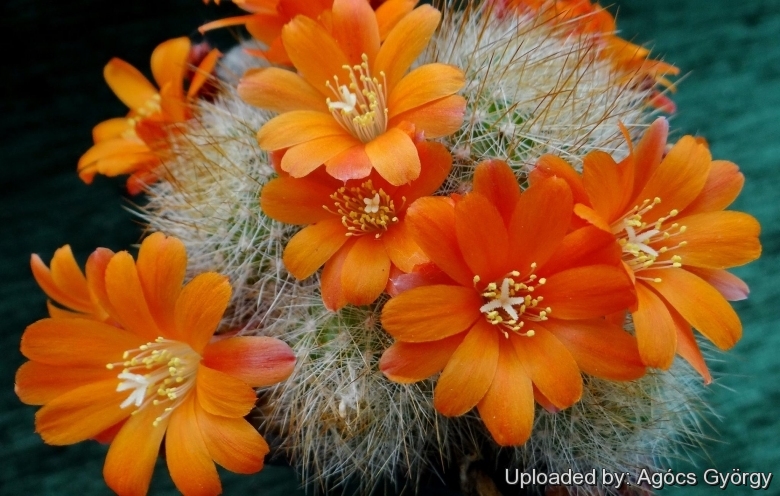
Origin and Habitat: Sucre, Chuquisaca, Bolivia.
Habitat: It is found in high, dry, rocky grasslands in rocky slopes of the Andes in fully exposed sites. The dense covering of spines reduces the interception of solar radiation by the stem surface lowering the risks of overheating the apex during a summer day and of freezing during a winter night.
Synonyms:
Rebutia fiebrigii (Gürke) Britton & Rose in L.H.Bailey & L.H.Bailey
Stand. Cycl. Hort. 5: 2915. 1916
Synonymy: 54
- Rebutia fiebrigii (Gürke) Britton & Rose in L.H.Bailey & L.H.Bailey
- Aylostera fiebrigii (Gürke) Backeb. in Backeb. & F.M.Knuth
- Echinocactus fiebrigii Gürke
- Echinorebutia fiebrigii (Gürke) Frič & Kreuz.
- Rebutia albipilosa F.Ritter
- Aylostera albipilosa (F.Ritter) Backeb.
- Rebutia archibuiningiana F.Ritter
- Aylostera archibuiningiana hort.
- Aylostera fiebrigii var. archibuiningiana hort. sensu D.R.Hunt
- Rebutia buiningiana F.Ritter non Rausch
- Rebutia spinosissima var. archibuiningiana hort. sensu Pilbeam, E.F.Anderson
- Rebutia cajasensis F.Ritter
- Aylostera cajasensis (F.Ritter) Mosti & Papini
- Rebutia cintiensis F.Ritter
- Aylostera cintiensis (F.Ritter) Mosti & Papini
- Rebutia donaldiana A.B.Lau & G.D.Rowley
- Aylostera donaldiana (A.B.Lau & G.D.Rowley) Mosti & Papini
- Rebutia fiebrigii var. azurduyensis (J.de Vries)
- Aylostera azurduyensis J.de Vries
- Aylostera fiebrigii var. azurduyensis (J.de Vries) Mieczak.
- Rebutia azurduyensis (J.de Vries) hort.
- Rebutia fiebrigii var. densiseta (Cullmann) Oeser
- Rebutia fiebrigii f. densiseta Cullmann
- Rebutia fiebrigii var. vulpes F.Ritter
- Rebutia flavistyla F.Ritter
- Aylostera flavistyla (F.Ritter) Mosti & Papini
- Rebutia hoffmannii Diers & Rausch
- Aylostera hoffmannii (Diers & Rausch) Mosti & Papini
- Rebutia ithyacantha (Cárdenas) Diers
- Mediolobivia ithyacantha Cárdenas
- Rebutia jujuyana Rausch
- Aylostera jujuyana (Rausch) Mosti & Papini
- Rebutia kieslingii Rausch
- Aylostera kieslingii (Rausch) Mosti & Papini
- Rebutia lateritia n.n.
- Aylostera lateritia n.n.
- Rebutia muscula F.Ritter & Thiele
- Aylostera muscula (F.Ritter & Thiele) Backeb.
- Rebutia pulchella Rausch
- Aylostera pulchella (Rausch) W.Haage
- Rebutia pulchella var. prolifera Rausch
- Rebutia simoniana Rausch
- Aylostera simoniana (Rausch) Mosti & Papini
- Rebutia sp. Huari Huari
- Rebutia spinosissima Backeb.
- Aylostera spinosissima Backeb. in Backeb. & F.M.Knuth
- Rebutia tamboensis F.Ritter
- Aylostera tamboensis (F.Ritter) Mosti & Papini
- Rebutia vallegrandensis Cárdenas
- Aylostera pumila A.B.Lau, n.n.
- Aylostera vallegrandensis (Cárdenas) Mosti & Papini
- Rebutia walteri Diers
- Aylostera walteri (Diers) Mosti & Papini
Description: Rebutia pulchella var. proliferaSN|4932]]SN|15735]] is probably one of the many geographical forms of the extremely variable Rebutia fiebrigiiSN|4932]]SN|4932]]. It is a small mound-forming cactus spreading out to 15 cm, with glassy-white, silky, short spines and light green tubercles thickly covering the body. It produces vibrant orange-red flower.
Habit: Mound-forming plant with bristly white spines. It grows quite close to the ground and offsets only with age. It would appear that in cultivation they grow larger and cluster more vigorously than in habitat.
Stem: 3 cm wide, 4 cm tall, dark, flat, covered by distinctive tubercles similar to a Mammillaria, that are easy to see through the small spines.
Spines: White, fine and soft.
Flowers: Startling bright orange, funnel-shaped, 4,5 cm. long, 4 cm diameter from the base of the stems. Stigma lobes white.
Blooming season: Flowers are produced profusely in spring, and remain open for up to six days.
Fruit: Tiny, berrylike, hidden among the spines, bursting when ripe.
Remarks: Nowadays, under the name of Rebutia fiebrigiiSN|15735]]SN|4932]], botanists include several different forms, that were previously regarded as independent species.
Subspecies, varieties, forms and cultivars of plants belonging to the Rebutia fiebrigii group
 Rebutia albipilosa F.Ritter: "White-haired Crown" It is a plant from northern Argentina.The body is made invisible by countless long, soft, hair-like white spines.It produces vibrant orange-red flowers.
Rebutia albipilosa F.Ritter: "White-haired Crown" It is a plant from northern Argentina.The body is made invisible by countless long, soft, hair-like white spines.It produces vibrant orange-red flowers. Rebutia archibuiningiana F.Ritter: The body is made invisible by glassy-white to yellowish, silky, short spines. It produces vibrant orange-red flowers. Distribution: Tarija, Bolivia.
Rebutia archibuiningiana F.Ritter: The body is made invisible by glassy-white to yellowish, silky, short spines. It produces vibrant orange-red flowers. Distribution: Tarija, Bolivia.- Rebutia cintiensis F.Ritter
- Rebutia donaldiana A.B.Lau & G.D.Rowley: "Donald’s Red Crown"n" It develops a dense clump of small, dark heads with brown spines which make a perfect backdrop for the small, dark orange-red, numerous flowers. It quickly begins to form a large, tight mound and it then proceeds to hide it all under a dense blanket of its flowers.
 Rebutia fiebrigii (Gürke) Britton & Rose in L.H.Bailey & L.H.Bailey: "Flame Crown" It’s a Bolivian mountain cactus, found at 3600m altitude, and therefore very hardy. It forms a cylinder about 6cm diameter and 10cm tall with few offsets and it produces striking, flame-red flowers over a long season.
Rebutia fiebrigii (Gürke) Britton & Rose in L.H.Bailey & L.H.Bailey: "Flame Crown" It’s a Bolivian mountain cactus, found at 3600m altitude, and therefore very hardy. It forms a cylinder about 6cm diameter and 10cm tall with few offsets and it produces striking, flame-red flowers over a long season. Rebutia fiebrigii var. azurduyensis (J.de Vries): has yellowish to brownish, silky, short spines and peculiar white blooms. Distribution: Azurduy to La Angostura, Bolivia.
Rebutia fiebrigii var. azurduyensis (J.de Vries): has yellowish to brownish, silky, short spines and peculiar white blooms. Distribution: Azurduy to La Angostura, Bolivia. Rebutia fiebrigii var. densiseta (Cullmann) Oeser: has stronger and very dense brownish spines. Distribution: Chuquisaca, Bolivia.
Rebutia fiebrigii var. densiseta (Cullmann) Oeser: has stronger and very dense brownish spines. Distribution: Chuquisaca, Bolivia.- Rebutia fiebrigii var. vulpes F.Ritter
 Rebutia flavistyla F.Ritter
Rebutia flavistyla F.Ritter Rebutia hoffmannii Diers & Rausch: similar to Rebutia spinosissima, with denser, very fine, tight, white spines, with brownish tips, and outer petals with purple-reddish shades. Distribution: Argentina (Salta) and Bolivia (Tarija).
Rebutia hoffmannii Diers & Rausch: similar to Rebutia spinosissima, with denser, very fine, tight, white spines, with brownish tips, and outer petals with purple-reddish shades. Distribution: Argentina (Salta) and Bolivia (Tarija).- Rebutia ithyacantha (Cárdenas) Diers
- Rebutia jujuyana Rausch
- Rebutia kieslingii Rausch
 Rebutia lateritia n.n.: has brick red flowers. Distribution: Potosi to Ballestro, Bolivia.
Rebutia lateritia n.n.: has brick red flowers. Distribution: Potosi to Ballestro, Bolivia. Rebutia muscula F.Ritter & Thiele: "Little Mouse" It comes from south Bolivia; it is distinguished by its soft white spination and orange flowers and it blooms heavily in May, continuing until September/October with always at least a few flowers. It is especially desirable for the small size of its main body, with the offsets held closely, usually in a pattern reminiscent of a classical sculpture.
Rebutia muscula F.Ritter & Thiele: "Little Mouse" It comes from south Bolivia; it is distinguished by its soft white spination and orange flowers and it blooms heavily in May, continuing until September/October with always at least a few flowers. It is especially desirable for the small size of its main body, with the offsets held closely, usually in a pattern reminiscent of a classical sculpture. Rebutia narvaecensis (Cárdenas) Donald: has 10-30 thin, needle-like whitish to yellowish pines, 2-5 mm long, and numerous pale pink flowers. Distribution: Bolivia. Narvaez (Department of Tarija, O'Connor Province)
Rebutia narvaecensis (Cárdenas) Donald: has 10-30 thin, needle-like whitish to yellowish pines, 2-5 mm long, and numerous pale pink flowers. Distribution: Bolivia. Narvaez (Department of Tarija, O'Connor Province) Rebutia pulchella Rausch
Rebutia pulchella Rausch Rebutia pulchella var. prolifera Rausch
Rebutia pulchella var. prolifera Rausch Rebutia simoniana Rausch
Rebutia simoniana Rausch Rebutia sp. Huari Huari
Rebutia sp. Huari Huari Rebutia vallegrandensis Cárdenas
Rebutia vallegrandensis Cárdenas
Bibliography: Major references and further lectures
1) Edward Anderson “The Cactus family” Timber Press, Incorporated, 2001
2) James Cullen, Sabina G. Knees, H. Suzanne Cubey "The European Garden Flora Flowering Plants: A Manual for the Identification of Plants Cultivated in Europe, Both Out-of-Doors and Under Glass" Cambridge University Press, 11/Aug/2011
3) David R Hunt; Nigel P Taylor; Graham Charles; International Cactaceae Systematics Group. "The New Cactus Lexicon" dh books, 2006
4) N. L. Britton, J. N. Rose “The Cactaceae. Descriptions and Illustrations of Plants of the Cactus Family.” Volume 4, The Carnegie Institution of Washington, Washington 1923
5) Curt Backeberg “Die Cactaceae: Handbuch der Kakteenkunde” Gustav Fischer Verlag, Stuttgart New York 1982–1985
6) Backeberg, Curt "Das Kakteenlexikon" p. 70, 1966
7) Pilbeam, John "Rebutia" (ISBN 0-9528302-2-1)
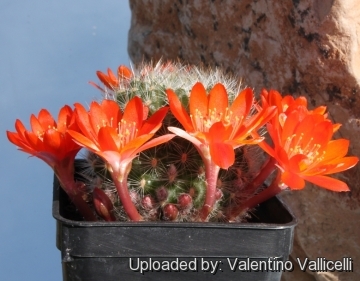
Aylostera pulchella var. prolifera (Rebutia pulchella var. prolifera) Photo by: Valentino Vallicelli

Aylostera pulchella var. prolifera (Rebutia pulchella var. prolifera) Photo by: Valentino Vallicelli
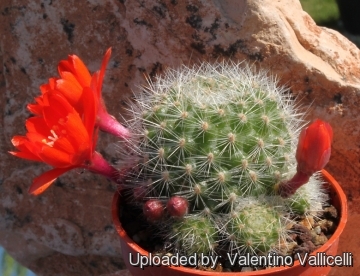
Aylostera pulchella var. prolifera (Rebutia pulchella var. prolifera) Photo by: Valentino Vallicelli
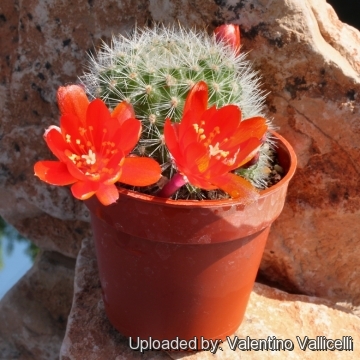
Aylostera pulchella var. prolifera (Rebutia pulchella var. prolifera) Photo by: Valentino Vallicelli
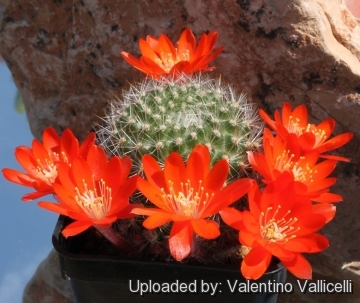
- Field number WR597 (collector W. Rausch, ) Locality: Sucre, Chuquisaca, Bolivia (Rebutia pulchella var. prolifera) Photo by: Valentino Vallicelli
The gallery now contains thousands of pictures, however it is possible to do even more. We are, of course, seeking photos of species not yet shown in the gallery but not only that, we are also looking for better pictures than those already present. Read More...
Cultivation and Propagation: Rebutia pulchella var. proliferaSN|4948]]SN|15735]] is a summer grower species that is easy to cultivate and recommended for beginners. The whole Rebutia fiebrigiiSN|4932]]SN|4932]] complex has delightful flowers and the plants remain compact, and clumps can easily be managed by division. Another advantage is that the plants are cold hardy in winter if kept dry.
Growth rate: It is a slow growing but easily flowering species that will make clumps given the best conditions.
Soils: This species is easy to cultivate in a very open mineral mix with at least 50% sand or pumice grit and a pH slightly on the acidic side.
Repotting: It is better that they are repotted regularly. Pots should be only slightly larger than the plant and root system. Repotting will increase the number and size of stems, and will increase the number of flowers produced. Repot yearly until they reach about 100 mm in size, then every two or three years will suffice. Repotting is best done at the end of winter, but can be done at other times, too. Do not water for a couple of weeks after repotting, to reduce risk of root rot via broken roots. A layer of 'pea' gravel at the bottom of the pot improves drainage. A layer of decorative gravel as a top dressing helps prevent the caking of the potting mix, which decreases the rate of water absorption. It also keeps the perlite and pumice from blowing everywhere, and looks nice.
Watering: It requires full sun or light shade and careful watering to keep plant compact, and maintain strong and dense spines and allow the pot to dry out between waterings. Keep dry in winter at a minimum temperature of 0°C. Rebutia albipilosaSN|15735]]SN|4948]] tends to rot if too wet. The plants can be placed outdoors in April, but protected from rain and direct sunlight. Water them thoroughly when placed out, and again in two weeks, and again in one week. After one month the plants are ready to be placed out in full sun and full rain for the summer. During dry spells the collection is watered once a week, during hot dry spells, twice a week.
Fertilization: Feed with a high potassium fertilizer in summer.
Hardiness: It is reputedly resistant to frost if kept on the dry side prior to, and during, cold weather and requires a winter rest period (hardy to -7° C, or less for short periods). Rebutias grow in nature at high altitudes, and do not thrive well at high temperatures in cultivation. They will often go dormant in mid-summer, and resume growth again when the weather cools in late August. They can tolerate amazingly low temperatures for long periods of time. All species can take a frost, even when not bone dry. It is generally accepted that plants kept at too high a temperature, or watered too much during the winter rest period, will not bloom the following year. They will be perfectly happy in pots outdoors from April to September if protected from torrential rain and hail.
Exposition: The plant tolerates extremely bright situations but enjoys filtered sunlight or afternoon shade, inside it needs bright light, and some direct sun. Tends to bronze in strong light, which encourages flowering and heavy spine production, but is likely to suffer from sun scorch or stunted growth if over exposed to direct sunlight during the hottest part of the day in summer.
Uses: It is an excellent plant for container growing. It always looks good and stays small. It look fine in a cold greenhouse and frame or outdoor in a rockery.
Pests & diseases: All, especially the young, are susceptible to red spider mites.
Rot: This species is particularly easy and accommodating, seldom suffer of cryptogamic diseases. Rot it is only a minor problem with rebutias if the plants are watered and “aired” correctly. If they are not, fungicides won't help all that much.
Propagation: Offsets, seeds. Seeds germinate in 7-14 days at 21-27° C in spring, remove gradually the glass cover as soon the plants will be well rooted (ca 1-2 weeks) and keep ventilated, no full sun for young plants! To make a cutting twist off a branch and permit it to dry out a couple of weeks, lay it on the soil and insert the stem end partially into the soil. Try to keep the cutting somewhat upright so that the roots are able to grow downward.
Note: It would appear that in cultivation they grow larger and cluster more vigorously than in habitat.
| Your Actions | |
|---|---|
| Back to Aylostera index | |
| Back to Cactaceae index | |
 |
Back to Cacti Encyclopedia index |
Privacy stantement - Terms and conditions - How to cite - About us - Feedback - Donate




